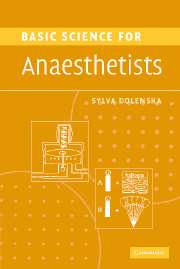Book contents
- Frontmatter
- Contents
- List of abbreviations and symbols
- List of figure captions
- Forewords
- Preface
- Preface to the second edition
- Part 1 Physics, mathematics, statistics, anaesthetic apparatus
- 1 Gas compression, relationship of volume, pressure and temperature
- 2 Real gas compression
- 3 Flow and resistance
- 4 Heat, vaporization and humidification
- 5 Simple mechanics 1: mass, force, pressure
- 6 Simple mechanics 2: work and power
- 7 Mathematical concepts
- 8 Exponentials 1: the curves
- 9 Exponentials 2: properties of exponential decay curve
- 10 Descriptive statistics
- 11 Presentation of data
- 12 Receiver operating characteristic curve
- 13 Gas supply and pressure
- 14 The circle system
- 15 The Mapleson A (Magill) breathing system
- 16 T-pieces
- 17 Lung filling with automatic lung ventilators
- Part 2 Clinical measurement
- Part 3a Physiology: the cardiovascular system
- Part 3b Physiology: the respiratory system
- Part 4 Pharmacology
- Further Reading
- Index
6 - Simple mechanics 2: work and power
from Part 1 - Physics, mathematics, statistics, anaesthetic apparatus
Published online by Cambridge University Press: 13 August 2009
- Frontmatter
- Contents
- List of abbreviations and symbols
- List of figure captions
- Forewords
- Preface
- Preface to the second edition
- Part 1 Physics, mathematics, statistics, anaesthetic apparatus
- 1 Gas compression, relationship of volume, pressure and temperature
- 2 Real gas compression
- 3 Flow and resistance
- 4 Heat, vaporization and humidification
- 5 Simple mechanics 1: mass, force, pressure
- 6 Simple mechanics 2: work and power
- 7 Mathematical concepts
- 8 Exponentials 1: the curves
- 9 Exponentials 2: properties of exponential decay curve
- 10 Descriptive statistics
- 11 Presentation of data
- 12 Receiver operating characteristic curve
- 13 Gas supply and pressure
- 14 The circle system
- 15 The Mapleson A (Magill) breathing system
- 16 T-pieces
- 17 Lung filling with automatic lung ventilators
- Part 2 Clinical measurement
- Part 3a Physiology: the cardiovascular system
- Part 3b Physiology: the respiratory system
- Part 4 Pharmacology
- Further Reading
- Index
Summary
Work is the product of force acting along a distance: W = F.l. Its unit is 1 joule (J), equal to 1 N m, which equals 1 kg.m2 per s2.
Doing work can be visualised as moving an object using a certain force from one place to another; the force which contributes to the work is in the direction of the movement. The work involved is the product of the force used and the distance between the two places. Reciprocal relationship between force and distance for constant amount of work applies. This reciprocal relationship is used in practice in simple mechanical devices to save force: a ramp was used by the ancient Egyptians to move some giant stone blocks up the pyramid. The longer the ramp, the less force was needed to push a block up to the same height (pushing an object up a steep slope against gravity needs greater force, and therefore is more exhausting). In Figure 16, the rectangular hyperbola is the line of equal work (isoerg). The points chosen on the line illustrate that for a distance n-times longer, the force used is n-times smaller to make the same amount of work.
When doing work, we expend energy; work is in fact equivalent to energy, hence the other non-SI unit of energy – kilocalorie (kcal). Thermal energy, kinetic energy, potential energy are all forms of energy; they can change from one form to another but the total energy remains the same.
- Type
- Chapter
- Information
- Basic Science for Anaesthetists , pp. 22 - 25Publisher: Cambridge University PressPrint publication year: 2006



